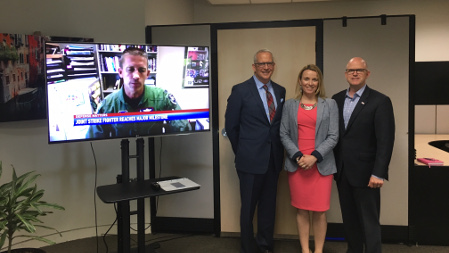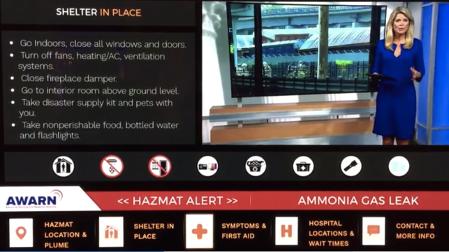AWARN Previews Next-Gen Advanced Alerting Features
ARLINGTON, VA.–Marking its one-year anniversary, the AWARN Alliance provided a preview of advanced emergency alerting capabilities via Next Gen TV that will be demonstrated at the 2017 NAB Show.

(L to R): John Lawson, executive director, AWARN Alliance, Fiona James, AWARN Alliance deputy director, and Sam Matheny, NAB CTO
The demonstration of the Advanced Warning and Response Network—held at Sinclair Broadcast Group’s Washington, D.C. ABC affiliate WJLA-TV—was designed to show how the ATSC 3.0 broadcast standard, which will be approved within the next several months, will allow broadcasters to dramatically upgrade the content, pervasiveness, and reliability of disaster warning and recovery information to TVs and mobile devices, according to AWARN Alliance Executive Director John Lawson.
AWARN will leverage other powerful features of Next-Gen TV, including the ability to “wake up” devices, robust indoor and mobile reception, personalization, and integration with hybrid networks. AWARN alerts can also be delivered to mobile devices even if the cellular network is overloaded or the electric grid is down.
“Geo-targeted, rich media AWARN alerts will give people a whole new level of life-saving information, literally at their fingertips,” Lawson said. “AWARN has the ability to deliver not only text, but photos, surveillance video, storm tracks, plume models, evacuation routes, shelter-in-place instructions, hospital wait times, power outages, and many other forms of vital content.”
These capabilities will far exceed emergency systems available to the American public today, primarily the Emergency Alert System (EAS), rooted in the Cold War, with its familiar tones and bars for radio and television, and Wireless Emergency Alert (WEA) text messages, currently limited to 90 characters, distributed by wireless carriers. “Because of the flexibility of ATSC 3.0, AWARN can easily transmit multilingual and accessible media as well,” Lawson said. The WEA, which was initiated after 9/11, will be expanded to provide over 300 characters in the future.
Lawson noted that AWARN can be used in conjunction with WEA when cellular networks can become overwhelmed. “I think [broadcasters] and wireless and going to be able to work together on this,” he said, adding that the advantages of broadcasting’s one-to-many transmission approach, coupled with ATSC 3.0’s hybrid IP/broadcast technology, will provide a more comprehensive emergency alert network. He used the Integrated Public Alert Warning System (iPAWS), which was created in 2006 to illustrate this cooperation.
“[The concept of] iPAWS is an excellent one in that alerting should be a ‘network of networks’ and wherever one network touches another in a mesh, then that alert should be relayed across the new network,” Lawson said. “So eventually we think the Wireless Emergency Alert and what we’re doing can work together. But because we’re using the television airwaves to send the alert directly to the device, whether it’s in your living room or in your hand, we don’t need the cellular network. But if the cellular network is available, we can embed urls, or we can embed the right hashtag, for example.”
NAB SHOW DEMOS
A key goal of the Alliance is to develop models that can be adopted seamlessly as ATSC 3.0 is launched by early adopter stations in 2018. Lawson said the Alliance is making steady progress toward that goal, including the following demonstrations at the NAB Show:
• AMBER: With the support of the National Center for Missing and Exploited Children, WJLA in Arlington, Va., and LG Electronics and its Zenith affiliate, the Alliance has produced an advanced AMBER alert demo.
• Tornado: With ABC 33/40 in Birmingham, Ala. and LG/Zenith, the Alliance has produced a tornado warning based on the real events of April 27, 2011, a “super outbreak” that claimed more than 250 lives in the Birmingham-Tuscaloosa area of Alabama.
• Chemical spill: And with WJLA, LG/Zenith, and Digital Alert Systems, the Alliance has produced a “HazMat” chemical spill alert, loosely based on the May 2016 CSX train derailment in Northeast Washington, DC.
Triveni Digital also supported production of each demo. Currently WRAL in Raleigh, N.C., with the support of UNC-TV in Chapel Hill, is producing an active shooter alert that includes encrypted content for first responders.
The three prototypes encoded by LG for ATSC 3.0 can be viewed at the Next-Gen TV Hub, booth L11, in the Grand Lobby of Central Hall at the Las Vegas Convention Center.

AWARN will include several demos of its alert system at the Next-Gen TV Hub, booth L11, in the Grand Lobby of Central Hall at the Las Vegas Convention Center during the NAB Show.
To test and demonstrate broadcasters’ flexibility in implementing advanced alerting, NAB PILOT has re-encoded two of the alerts as HTML5 apps that can be broadcast through the ATSC 3.0 signal and received on tablets via a home gateway device. Those demos can be viewed at Futures Park in NAB PILOT booth N1838FP in North Hall.
The Alliance will host an executive breakfast on Wednesday, April 26 from 8-9 a.m. in Westgate Conference Rooms 1-2 that will focus on synergies between AWARN alerts and Next Gen TV business models. Contact AWARN Alliance Deputy Director Fiona James to register.
AWARN ALLIANCE EXPANDS
Lawson also used the anniversary to announced the expansion of membership into the AWARN Allliance, which is a coalition of commercial and public broadcasters, consumer electronics and broadcast technology companies, national trade groups, and service providers who have come together to develop and deploy AWARN. Membership in the Alliance has more than doubled since its founding just one year ago, adding public broadcasters, national groups, tech companies, and law firms.
The Alliance, along with the Consumer Technology Association, the National Association of Broadcasters, and America’s Public Televisions Stations, is a signatory to the April 2016 “joint petition” to the Federal Communications Commission requesting rules to allow broadcasters to begin transmitting in the ATSC 3.0 standard on a voluntary basis. The FCC approved a Notice of Proposed Rulemaking for that purpose in February.
Get the TV Tech Newsletter
The professional video industry's #1 source for news, trends and product and tech information. Sign up below.
Tom has covered the broadcast technology market for the past 25 years, including three years handling member communications for the National Association of Broadcasters followed by a year as editor of Video Technology News and DTV Business executive newsletters for Phillips Publishing. In 1999 he launched digitalbroadcasting.com for internet B2B portal Verticalnet. He is also a charter member of the CTA's Academy of Digital TV Pioneers. Since 2001, he has been editor-in-chief of TV Tech (www.tvtech.com), the leading source of news and information on broadcast and related media technology and is a frequent contributor and moderator to the brand’s Tech Leadership events.

